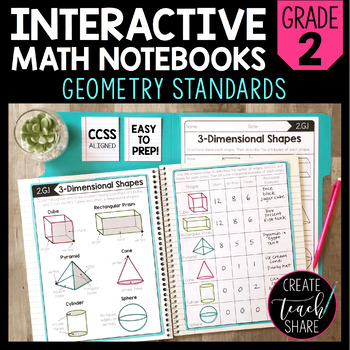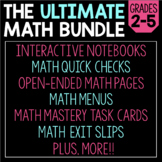Math Interactive Notebook 2nd Grade Geometry
Create Teach Share
64.9k Followers
Grade Levels
1st - 3rd
Subjects
Resource Type
Standards
CCSS2.G.A.1
CCSS2.G.A.2
CCSS2.G.A.3
Formats Included
- PDF
Pages
29 with answer key
Create Teach Share
64.9k Followers
What educators are saying
Create Teach Share creates all of the best math resources I love every single product I've downloaded and used!
I love how this resource is laid out with information on one side and practice problems on the other. Straightforward and easy to follow. Thanks!
Also included in
- What are Interactive Math Notebooks?Interactive math notebooks are teaching pages used to introduce and teach new math concepts and skills. Each set of notebook pages includes definitions, explanations, rules, and/or algorithms that may be needed to address each standard. Sample and practice problemPrice $24.50Original Price $29.75Save $5.25
- This BUNDLE is a collection of all of my 2nd grade math resources!!★ Interactive Notebook Pages★ Math Quick Checks ★ Math Exit Slips★ Math Menus (Perfect for homework or early finishers!!)★ Math Mastery Task CardsFeel free to email with any questions or comments at createteachshare@gmail.comBe surePrice $44.50Original Price $56.00Save $11.50
- This BUNDLE includes everything you need for 2nd to 5th grade math!!★ Interactive Notebook Pages★ Math Quick Checks★ Math Menus (Perfect for homework or early finishers!!)★ Open-Ended Math Pages★ Math Exit Slips★ Math Mastery Task Cards★ Printables for Fractions, Decimals, Measurement, and Geometry★Price $152.95Original Price $277.80Save $124.85
Description
What are Interactive Math Notebooks?
Interactive math notebooks are teaching pages used to introduce and teach new math concepts and skills. Each set of notebook pages includes definitions, explanations, rules, and/or algorithms that may be needed to address each standard. Sample and practice problems are also included to be used for guided practice. Once completed, these notebook pages serve as anchor charts for students to refer back to as a reference tool throughout the year.
How do I use them with my students?
Notebook pages can be used to introduce, reinforce, or review math standards. They can be used for direct instruction for a whole class, or in small groups. Students first cut out the pages and other pieces, and glue them into their notebooks. With teacher guidance, students take notes and work out practice problems related to the standard being addressed. Students can then highlight or add color to their notebook pages.
What materials are needed?
→ A spiral notebook for each student.
→ Scissors
→ Glue Sticks
→ Pencils
→ Colored pencils, crayons, and/or markers (optional)
What is included in this resource?
→ Notebook pages for each standard. Each concept or skill includes a double-page spread. More than one set may be included for certain standards that cover multiple skills.
→ Student Notebook Cover
→ Table of Contents (2 to 3 pages will be needed for each student)
→ Answer Key
What standards are covered in this resource?
Triangles (2.G.1)
Quadrilaterals (2.G.1)
Pentagons & Hexagons (2.G.1)
Cubes (2.G.1)
Partitioning a Rectangle (2.G.2)
Equal Shares (2.G.3)
Interactive math notebooks are teaching pages used to introduce and teach new math concepts and skills. Each set of notebook pages includes definitions, explanations, rules, and/or algorithms that may be needed to address each standard. Sample and practice problems are also included to be used for guided practice. Once completed, these notebook pages serve as anchor charts for students to refer back to as a reference tool throughout the year.
How do I use them with my students?
Notebook pages can be used to introduce, reinforce, or review math standards. They can be used for direct instruction for a whole class, or in small groups. Students first cut out the pages and other pieces, and glue them into their notebooks. With teacher guidance, students take notes and work out practice problems related to the standard being addressed. Students can then highlight or add color to their notebook pages.
What materials are needed?
→ A spiral notebook for each student.
→ Scissors
→ Glue Sticks
→ Pencils
→ Colored pencils, crayons, and/or markers (optional)
What is included in this resource?
→ Notebook pages for each standard. Each concept or skill includes a double-page spread. More than one set may be included for certain standards that cover multiple skills.
→ Student Notebook Cover
→ Table of Contents (2 to 3 pages will be needed for each student)
→ Answer Key
What standards are covered in this resource?
Triangles (2.G.1)
Quadrilaterals (2.G.1)
Pentagons & Hexagons (2.G.1)
Cubes (2.G.1)
Partitioning a Rectangle (2.G.2)
Equal Shares (2.G.3)
Total Pages
29 with answer key
Answer Key
Included
Teaching Duration
2 months
Last updated Jul 12th, 2018
Report this resource to TPT
Reported resources will be reviewed by our team. Report this resource to let us know if this resource violates TPT’s content guidelines.
Standards
to see state-specific standards (only available in the US).
CCSS2.G.A.1
Recognize and draw shapes having specified attributes, such as a given number of angles or a given number of equal faces. Identify triangles, quadrilaterals, pentagons, hexagons, and cubes.
CCSS2.G.A.2
Partition a rectangle into rows and columns of same-size squares and count to find the total number of them.
CCSS2.G.A.3
Partition circles and rectangles into two, three, or four equal shares, describe the shares using the words halves, thirds, half of, a third of, etc., and describe the whole as two halves, three thirds, four fourths. Recognize that equal shares of identical wholes need not have the same shape.







